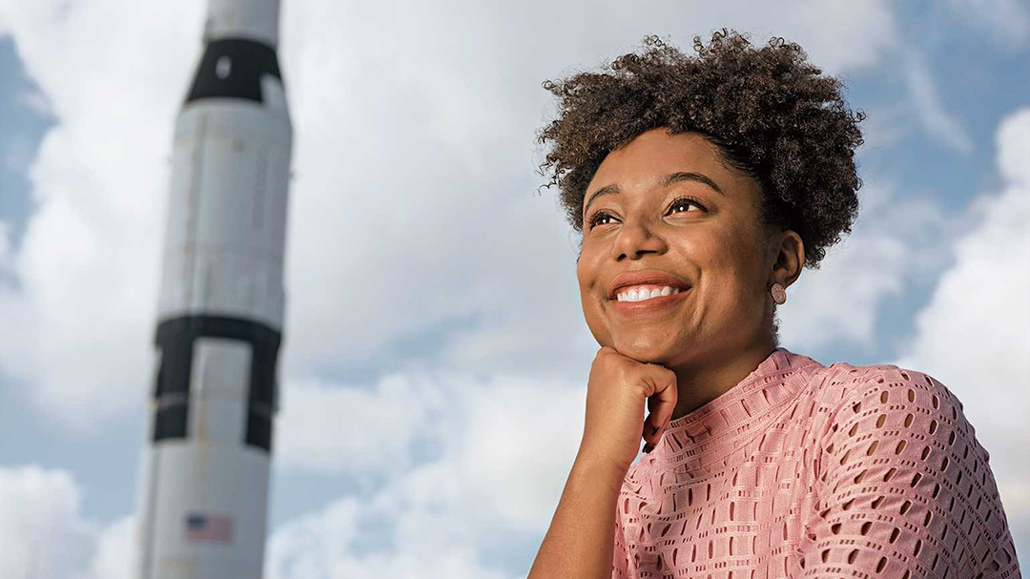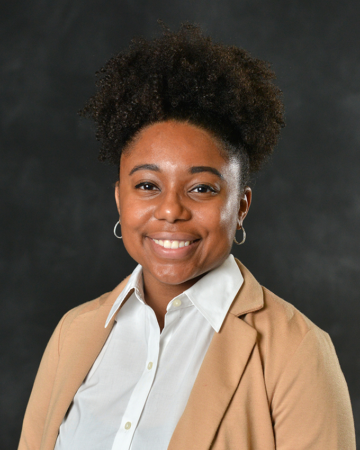Before working on spacecraft, this engineer overcame self-doubt
Tiera Fletcher has gone on to help design vehicles for travel to the moon and Mars

Tiera Fletcher has dreamed of working on spacecraft since her childhood. On the path to achieving this goal, Fletcher struggled with self-confidence. Now she travels to speak to students about how they can overcome that hurdle.
Michael A Schwarz
Like many kids, Tiera Fletcher wanted to be many different things when she was young. At times she wanted to be a mathematician, an inventor, a scientist and an architect. But when she was 11, she figured it out. She wanted to build rockets and airplanes. And since then, she has been reaching for the stars — or at least thinking about how to travel closer to them.
Today, she’s a structural engineer in San Antonio, Texas, at Boeing. That’s an aerospace company that makes airplanes and space vehicles. Fletcher has helped design vehicles that may someday shuttle people to the moon or Mars.
Long before Fletcher became a rocket scientist, she was a shy and timid kid. Though she consistently excelled in school, she was plagued by low self-confidence. She just didn’t believe in herself. But teachers and mentors helped her come out of her shell. That included her middle-school science teacher, who saw her potential and encouraged her to speak up. It also included her high school engineering teacher, who inspired Fletcher when she grew up to reach out to kids.
Fletcher wants kids to realize that believing in themselves is an important part of reaching their goals. In this interview, she shares her experiences and advice with Science News for Students. (This interview has been edited for content and readability.)
What inspired you to pursue your career?
When I was young, I had a passion for drawing and for building. If I were to draw a house, I would actually want to build it. I’d use materials like balsa wood and glue and stickers.

I also had a passion for mathematics that started quite early. My mom is an accountant. That’s someone who helps people or businesses keep track of money. She taught me about the fundamentals of mathematics. I’d use math to help her with couponing. We would go to the grocery store. She would have me calculate the total amount that the groceries cost. I’d subtract out the coupons, add in the tax — all in my head. So that’s how I’d practice math. My mom understood that since I didn’t complain about it, I must have a love for math. She just nurtured that love.
I decided to become an aerospace engineer at the age of 11. There was a program at my elementary school that taught the foundations of aerospace engineering. They provided flight simulators. They taught us about the forces objects experience as they fly through the air. They showed us how to make a really cool glider. They made aerospace super fun and interesting. That’s when I learned that I could be an engineer and focus on these very cool vehicles for space travel.
How did you get where you are today?
Ever since age 11, I remained focused on becoming an aerospace engineer. I even picked my activities and summer programs in middle school based on that goal. It also helped me to select my high school. I went to Wheeler High School in Marietta, Ga. They had a program that specialized in science, math and technology. It was out of my school district, so I rode the bus for an hour every morning from my home in Mableton, Ga. But I knew that it was the school for me and my goal. So I made it happen and so did my parents.
Wheeler offered an aerospace-engineering course and other engineering courses. Then, for college, I attended the Massachusetts Institute of Technology (MIT) in Cambridge. That was because they were number one in aerospace engineering. That just fit my goal. They’ve graduated so many astronauts and even have astronauts as professors. I knew that I had to go there.
Along the way, my biggest hurdle was truly believing in myself. It’s something that we all go through at some point in our lives. And it’s a battle that I fought up until I attended MIT. Even though I was excelling, I always thought that I didn’t have the capabilities to fulfill my dreams. I finally started to believe in myself my sophomore year in college. It was shortly after I accepted an internship with the Boeing Company. I was halfway through this really hard course for aerospace engineers at MIT. I realized I was able to do this work. And I looked in the mirror and said, “I believe in you.”
While I was focusing on school, I was also trying to become a well-rounded individual. So for kids who are seeking to excel in school, it’s also important to become the person that you want to be. That could mean getting involved in the community and helping others. For me, it was tutoring and mentoring and working for Habitat for Humanity for a bit. (Habitat for Humanity builds homes for people in need.)
In addition to your goals, you have to find other passions. I love to dance and play music. In college, I actually choreographed for an African dance team. It was exhilarating and so much fun. As far as instruments, I started with the piano at around the age of five or six. I later learned to play the xylophone, the violin and the saxophone.
How do you get your best ideas?
One way that I get my best ideas is silence. I just sit there and think about a topic. I think about how I can implement whatever the goal is or different avenues. Just by having that realm of silence and the room to think, that’s when the ideas appear. I write them down, probably in a notepad or in my phone. And I’m able to expand on those ideas later. I try and just write out whatever I’m thinking as quickly as possible before the idea slips away. I do this very frequently, almost every day.
What’s one of your biggest successes?
One of my greatest successes is marrying my best friend and becoming a mother. It’s something I’ve dreamed of. But after it happens, you can’t exactly calculate how things are going to turn out. You want to keep your little ones safe. But all sorts of different factors play a role. Another great success would be achieving my dream, which I had for more than a decade, of becoming an aerospace engineer. Lastly, another success would be getting to the point of believing in myself.
What’s one of your biggest failures, and how did you get past that?
I failed my first exam in my freshman year of college. During the first semester of your freshman year, MIT has what’s called a “pass-no record” system. All you have to do is make a passing grade. If you get anything else, it’s like you never took the class. So I was taking this course in my first semester and I received such a low grade. I think I got maybe 25 percent on this exam.
I just thought that I just couldn’t do it. I was ready to pack my things and head back to Georgia. I didn’t think that I would be able to succeed. But I took that moment of failure and figured out how to grow from it. I reached out to the professors, to the teaching assistants, to my peers who were thriving in the course. And I put my best foot forward.
What do you do in your spare time?
I travel a lot for outreach. I dedicate a lot of my spare time to reaching out to students of all ages. I want to let them know that they have the power to achieve their dreams. I try to give them advice so they can get to that point of confidence. I don’t want them to have to struggle for as long as I did. I also spend time with my family and friends. And then I try and get some dance numbers in there when I can. That’s usually just in the comfort of my home.
What piece of advice do you wish you had been given when you were younger?
Allow failures to be learning lessons. Just because you fail, it’s not a stopping point. It’s a time for you to reorganize your approach and your thoughts. You can still reach whatever goal it is that you’re trying to reach.
This Q&A is part of a series exploring the many paths to a career in science, technology, engineering and mathematics (STEM). It has been made possible with generous support from Arconic Foundation.







